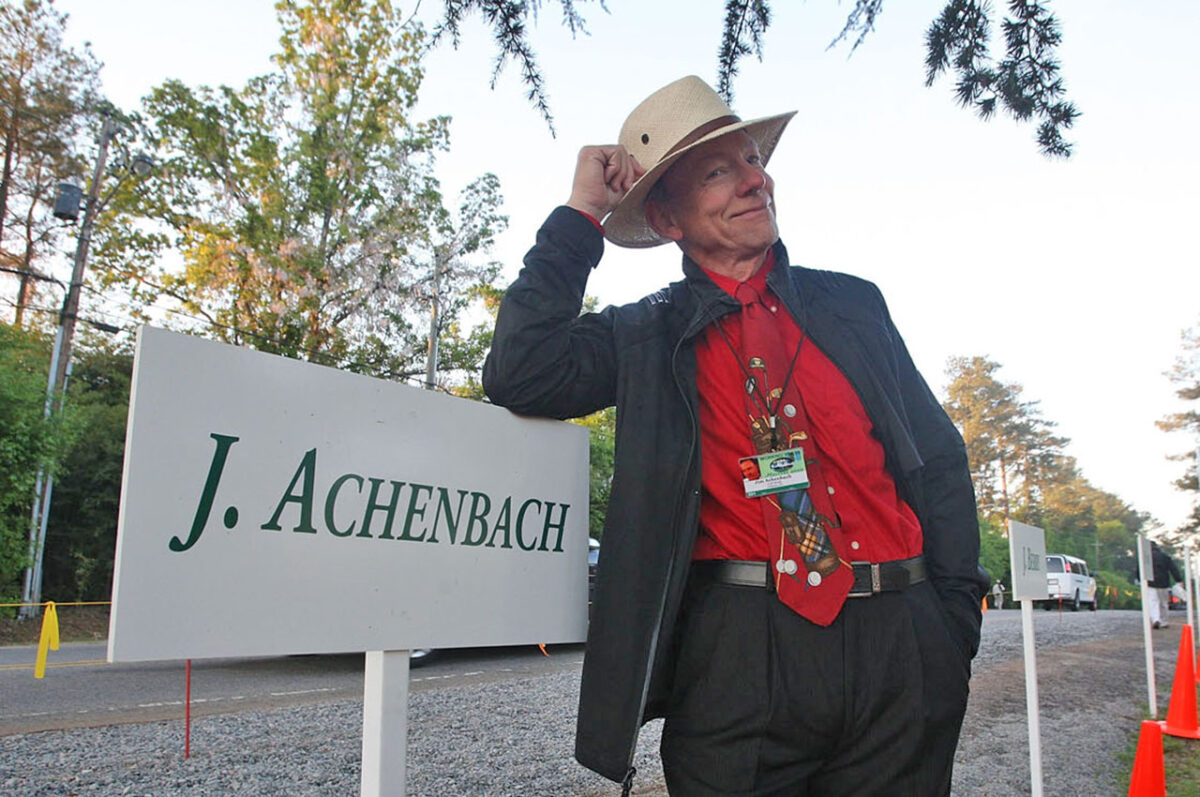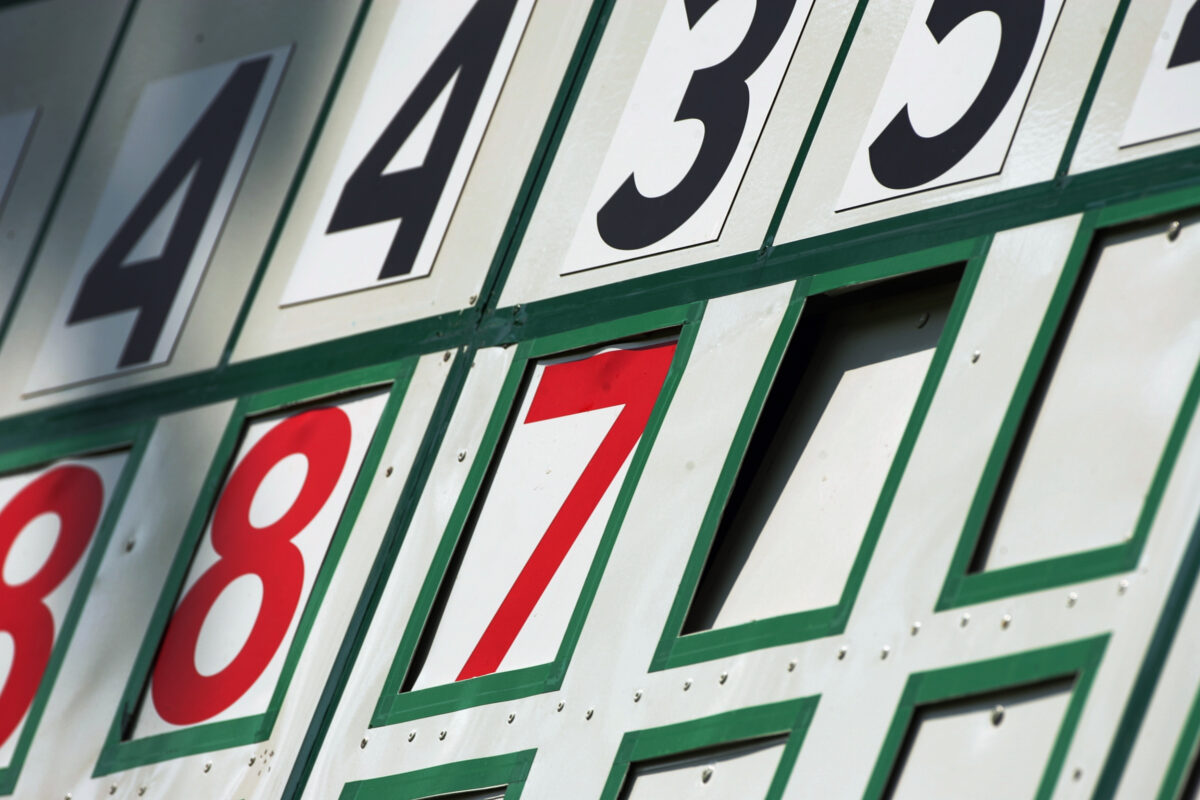James Achenbach – a wily, funny and infuriatingly clever golf writer who worked full-time for Golfweek for 24 years – passed away Friday, April 15. He was 78. His daughter, Omalley Ehren Abel, posted about his death on Facebook.
Achenbach’s initial forays into the pages of Golfweek began in the 1970s and grew into a full-time gig in 1991 after various stints at newspapers around the country, and he became a popular senior voice in golf writing. He attended more than 40 consecutive Masters, earning a personal parking spot at Augusta National Golf Club in 2010 along with the club’s Masters Major Achievement Award. He interviewed all the greats of the game, including Jack Nicklaus, Tiger Woods, Byron Nelson and many others. His breadth of knowledge was extensive, his enthusiasm catching.
In a career that started with persimmon-headed drivers and concluded after the introduction of hot-faced titanium rocket launchers, Achenbach put an emphasis on the people of golf. He had a particular affinity for amateur golfers and the many PGA of America professionals who promoted the game. He could hobnob with USGA or R&A executives just as easily as he would listen to the preachings of a local club fitter at a small, independently owned retail golf store. He was always happy to talk golf.
Tour pros were a source of amazement for Achenbach when it came to how they could swing a club, but they did not always receive such love when they strayed into controversial topics. For example, he once assailed Arnold Palmer’s support of non-conforming equipment that threatened to bifurcate the game. He feared the wrath of no one, be it Tour official or advertiser.
Family, his and others, was always special. Private about so much of his own life, his outward passion for people was contagious. Former Golfweek editor Jeff Babineau, on hearing of Achenbach’s passing, said they first met in Sarasota, Florida, while covering the old Bent Tree Classic. Achenbach had written a story about Nancy Lopez and her dad, Domingo, that Babineau says to this day is one of the most beautiful pieces he has ever read. Emphasis on ever, from an editor who has read many of the greats.
“There was no one who ever covered this game more passionate about golf and more passionate about relaying his love of the game to readers,” Babineau said. “He took it personally. Writing wasn’t work to James. It was a calling.”

He earned multiple awards from the Golf Writers Association of America, and in his quirky way that was all Achenbach, he made his acceptance speech an ode to the copy editor. That seems fitting, as he didn’t like to speak too much about himself, often beginning personal stories with a large sigh to express his frustration and fear of boring a listener about himself. He worked at the Sarasota Tribune, covering Florida State football and Bobby Bowden at one point, and the Mesa Tribune in Arizona – there surely were other beats and newspaper gigs that he never brought up. He owned residences in Orlando, the California desert and Oregon, but his bosses never seemed to know exactly where he was – for writers of his era, that kind of freedom was a gift.
His laugh was like nobody’s, a deep three-part cadence that rose in volume: “Ha. Haaa. HAAAA!” If you heard that laugh down the hall, you couldn’t help but investigate.
I had the greatest pleasure to be his editor on the equipment beat at Golfweek for 10 years until his retirement in 2015, and never have I seen a person so in love with his job. Covering a U.S. Open or writing about hosel length and lead tape, keeping secrets about his whereabouts and scouring the entire world of golf for his next “big, big important story,” Achenbach would vigorously chase any idea deep into a rabbit hole of research and personal testing. No topic was too big, no subject too esoteric.
Achenbach was opinionated and incredibly informed. He earned both through years of banging away on various keyboards, first a manual typewriter and later a laptop. He once grew so exasperated at me for not running one of his stories in print that he wouldn’t pick up the phone for a week – it basically was a story about a stick that could be massaged into sore muscles to make a golfer feel better, but the science behind the premise was dodgy at best. A week after I held the story, he showed up in our Orlando newsroom unannounced, saying he flew all the way from his home in California to apologize for his anger in person. Because Golfweek used to run all the scores from just about every tournament that halfway mattered, I knew he actually was in Florida to play a senior golf event, but that kind of juggling was part of his charm. He was one of a kind, and now I wish I had run that damn story about the stick.
In dealing with personal affairs, Achenbach was a softy of the highest order. He wept when I told him of my wife’s leukemia diagnosis in 2013. I last saw him about four years ago, both of us happy to cross paths at the annual PGA Merchandise Show, and he started the conversation with questions about her treatment and well-being. He frequently checked in on co-workers and friends in such a kind manner, quick with encouragement and congratulations when appropriate. I wish I could tell him of my wife’s remission – he would be beaming.
He was rumored to be an ace at free throw shooting on a basketball court, and he was a single-digit-handicap golfer who couldn’t get enough, playing anywhere with just about anyone, an ever-present and sometimes decaying Yankees cap screwed tight upon his head. He loved golf clubs – absolutely adored them – and would always seem to have some new driver or shaft in his carry bag, a wedge from a small manufacturer, or a putter that promised much even if it never delivered. After his retirement, he loved to compete and write about The Society of Seniors golf organization, still contributing pieces to various publications and websites.
His first piece for a then-fledgling Golfweek – published on May 22, 1975 – introduced his love of amateur golf. His topic was Dorsey Luke’s charge to victory at the DeSoto National Amateur Handicap Golf Championship in Bradenton, Florida.

His retirement column focused largely on his greatest frustration with the game: slow play. His final words after 40 years spent in Golfweek’s pages focused on the problem, as he simply despised wasting time on a course. Published on August 31, 2015, and titled “Retiring from Golfweek, not from life,” that column is posted below:
By James Achenbach
I find it amusing that hack is a word equally suitable for bad golf or bad journalism. At times, I have been guilty of each.
However, as I retire and ride into the sunset – with Decisions on the Rules of Golf in my saddlebag – I will not be guilty of talking endlessly about my career. Too indulgent for my tastes.
After four decades involved with Golfweek, it is more important to me to recognize the role of club professionals in boosting golf and promoting fast play. The men and women who choose golf as a profession must be teachers, philosophers, arbiters, confidants and storytellers. They must have sharp minds and accurate memories. Ever try to remember the name of every person you meet? Welcome to the PGA of America.
Ken Morton Sr., a member of the PGA Hall of Fame, runs the 36-hole Haggin Oaks golf facility for the city of Sacramento (Calif.). In 1958, when he was 18, he took his first job at Haggin Oaks. Now, 57 years later, he is a legend.
The entire golf-oriented Morton family, through the Morton Golf Foundation, has raised hundreds of thousands of dollars for local charities. A scholarship program has helped send hundreds of underprivileged young golfers to college.
Another veteran club professional, Tommy Moore of Palmetto Golf Club in Aiken, S.C., is a prominent example of how one person can make a huge difference.
In the 1930s and 1940s, many famous golfers adopted a ritual of practicing at Palmetto before traveling a short distance to compete in the Masters. Eventually, Palmetto fell on hard times financially, and that’s when Moore came to the rescue. Thanks to his persistence, the historic club is recognized today not only as one of America’s great 19th-century (1892) golf treasures but also as a distinguished supporter of amateur golf competition.
Slow play is one of golf’s biggest enemies, but two club pros in the western United States deserve mention for leading the campaign to rid it from golf as if it were a malignant weed.
Dick Hyland, head professional at The Country Club at DC Ranch in Scottsdale, Ariz., has won the Ed Updegraff Award for exemplifying the spirit of golf in Arizona. He also was named 2014 Golf Professional of the Year by the Southwest Section of the PGA of America.
To Hyland, fast golf is a way of life. He likes to play an 18-hole round each week with a different member. As a twosome, they ride. No, they fly.
“We are the first group out,” Hyland said, “and we finish anywhere between one hour and 40 minutes and two hours. We never take more than two hours.”
Golf professional J.D. Ebersberger, co-founder of The Palms Golf Club in La Quinta, Calif., quickly established three hours and 15 minutes as a target time for completing 18 holes.
A big reason for Ebersberger’s 3:15 vision is the course layout. Ebersberger, a member of the Hall of Fame of the Southern California PGA Section, hired architect Brian Curley to create an innovative old-timey design in which greens and tees are close together.
Groups missing the 3:15 mark usually finish within 3:30. The 4-hour round of golf virtually is extinct at The Palms.
Top 10 tips from Hyland and Ebersberger:
- Give golf professionals the clear authority to approach and advise plodding groups; Hyland’s first words to any slow group: “What can I do to help you?”
- Forget honors entirely; play ready golf at all times.
- Concentrate on determining your yardage before it is your turn to hit.
- Try this guideline: From the time you pick up your coin, you have 15 seconds in which to hit a putt.
- Another guideline: In the age of plastic spikes, experiment with rounds in which continuous putting is mandatory.
- The first golfer to hole out should hold the flagstick and replace it.
- Never park a golf cart on the front side of the green; park it as close as possible to the point of exit from the green.
- After hitting a shot, keep your club in your hand. Replace it in the bag only after the cart has stopped at its next position.
- In the age of distance-measuring devices, try this on par-3 holes: Spray paint the exact yardage to the flagstick from various tee locations.
- Courses might keep and even post a time sheet, noting start time, turn time and finish time for all groups. “We’re not trying to embarrass anybody,” Ebersberger said. “We’re just trying to make everybody aware of the time involved.”
Now, without a writing job for the first time in decades, what can I do to express myself? Wrestling with slow play would be a worthy cause: writing in depth about fast play and ready golf, organizing qualified speakers, creating leadership awards for speedy players.
Playing quickly should be every golfer’s mandate. We can retire from our jobs, but we can’t retire from the havoc created by slow play. Gwk


